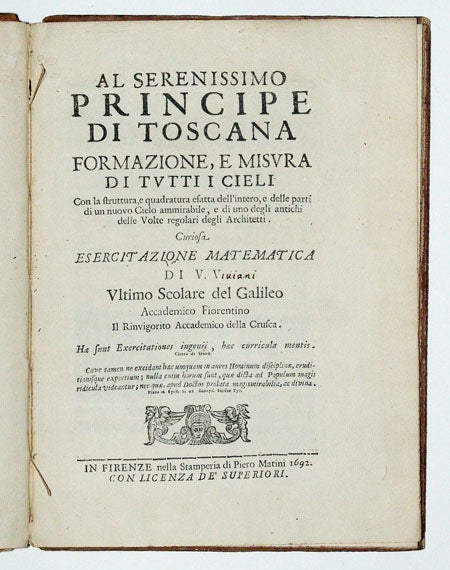
Al serenissimo Principe di Toscana, Formazione, e misura di tutti i cieli.
4to. [24.2 x 18 cm], xiv, 32 pp., (1) f. (“Ommessioni”), without initial blank, as often. Cancel on p. 17. Several corrections in ink by an early reader. Worming in upper and lower gutter. Bound in contemporary calf, spine perishing, boards loosening.
Very rare first and only edition of this book of geometrical problems proposed by Galileo’s last disciple, including Viviani’s own solution to the Florentine Enigma he had published earlier that year under a pseudonym. In the dedication to Prince Ferdinand de Medici, he identifies himself for the first time as the author of this challenge, which was occupying Europe’s foremost mathematicians. The problem was how to perforate a hemispheric arch with four equal windows in such a way that the residual surface could be squared. According to the mathematical historian Montucla (quoted in Riccardi), the solution Viviani presented here “is superior to all others.”
The Florentine Enigma drew many responses, most notably one by Leibniz who published it under the title Aenigma architectonico-geometricum Florentia (1692) and dedicated it, too, to Prince Ferdinand. The nature of the intersection of cylinder and hemisphere continued to occupy mathematicians until recent times; contributions to the discussion include Gregorius Maettig Kloss’ Einige Anwendungen des Florentiner Problems (1856), or Leopold Klein’s Über das Sogenannte Vivianische Fenster (1915).
Viviani’s Formazione includes seven new geometrical problems of a similar nature, most involving the intersection planes and solid objects and their squares. It is notable that even at this advanced age, when Viviani (1622-1703) had built a solid reputation on his own and Galileo had been dead for 50 years, the author identified himself on the title page and on every running head as “Ultimo Scolare del Galileo”—the last disciple of Galileo.
* Cinti 164 (mentioning the cancel on p. 17); Riccardi I.628-8; DSB XIV, 49.
Sold
